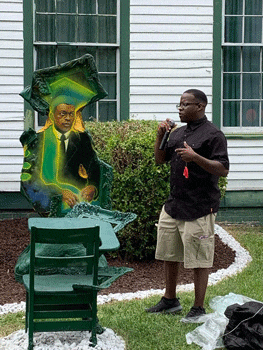
"I have enough space in here to work, so I figured I would save money and just focus on my craft," he says as he continues down one side of his garage slash studio. "Some paintings take months; some take years."
Mathis says art is an idea, and an idea cannot be contained. For a lot of his works, the frame itself is incomplete. As he walks around, he stops at a piece of artwork, the subject popping through the portion of the frame.
"An idea is bigger than what you know of it," he said. "When you come into something that inspires you, that's the tip of the iceberg. That's how I think about it."
He picks up a nine-foot piece of artwork and glances it over. He begins to talk about the importance of color and how everything real is made "piece by piece." Colors are layers. Everything has layers and dimensions, even when capturing human pigments. When he speaks about it, it's as if he's traveling down his own colorful, art-filled rabbit hole that leads to a land where knowledge transfers through art.
"You can use color to change the perspective of the room or environment. I want to show something visually and put it together."
He then returns to pacing and continues to talk.
For Mathis, art is a true testament to his will and patience when researching the history of the Black artists he is embodying. He has been doing a series of paintings that capture Black artists and the importance of their work. He says this is important work, but it is hard to capture history in a visually correct way. Once he does his research, he puts the pieces together with as much thought and detail as he says the history deserves.
"I have to work backwards. I have to look into peoples' families' lives. Most of their pictures are black and white pictures," he said. "I have to do a lot of research on my end to make sure I'm visually correct."
Mathis set out to build a career in the military with the Marines. He was an M249 Squad Automatic Weapon (SAW) gunner in the infantry and served during three deployments, two of which were combat-related. On his second deployment, Mathis saw a lot of close calls and felt sure on the third deployment, he "wasn't going to be so lucky." Fortunately for Mathis, he returned home, and he did so with a perspective that saw him approaching his life differently than he had before.
"At a young age, I was kind of thrown to the wolves … and from that point on, I could never not take things serious because I could see how serious life could be," he said.
When Mathis returned, he felt he was still making adjustments for the years he spent in the military. His family took notice and stepped in. For Mathis, it was a battle he didn't know he "was going through at the time."
"I went through day terrors. The whole nine yards," he said. "All of us try to play the strong role when you don't need to be that way. And that's why I took painting seriously."
He continues to pace and explains the pacing is a by-product of years of carrying ammunition. His back pain is a physical reminder of his former life and a reminder to give art everything he can.
Mathis first attended undergraduate school in Pennsylvania for art. The program was not right for him. He was "taught in a way you could see it coming." He wanted to feel challenged. He was searching for a teaching method he hadn't entirely found. He decided to transfer to Fayetteville State University, majoring in Studio Art. FSU is where he would eventually meet Soni Martin, Shane Booth and Dwight Smith — three professors he credits as impacting his view of the world and art. They let him be rebellious, he says, in his way.
"Most school settings, you can be put into a box and never know," he said. "It was a different experience. They let you find yourself. Then they taught you how to control yourself."
Mathis started with a love of drawing, but Smith convinced him to explore painting and taught him how to paint. Booth taught him perspective, and Martin taught him the intellectual side of art. He said she knew it so well; it felt like it was a part of her. He says that each of them brought him to a better understanding of himself and art.
He has now been painting for seven years, showing his work in different states, including South Carolina, Florida and Kansas. No matter where it is, though, it has all become about one thing for him — visually showing that art can be knowledge. It can embody history.
"Art has recorded our history in a way that stuck the emotion of it in there. It's visual glory. I didn't want to miss that within my work. I didn't want to miss the opportunity to teach someone while they are visually engaging in my work."
And above all else, he asks himself, "what can I do in my lifetime that will stand the test of time?" Mathis admits it's a lot to place upon himself, but his experiences to this point have taught him it's a crucial question.
It's a question he's obligated to ask for himself and those black artists that came before him.
When he thinks of his future projects or where he wants to take his art, he does so in terms of four to six months from now, even longer sometimes. He is focusing on featuring artists like Jacob Lawrence and displaying the importance of their work. Lawrence's paintings focused on The Great Migration — the time between 1916 and 1970 when African Americans moved to the Northeast searching for better jobs.
"I came across an artist that studied that time period. It showed me I should be doing for my generation what others have down for their generations," Mathis said, nodding his head. "There's a lot of things I feel that Black people didn't get to learn in the last 40 to 50 years. The lack of knowledge, discrimination … the whole nine. We all know."
For him, this project now is a way to honor people from periods where they may not have had the resources to record their pieces of history. Mathis would like to help carry that history into the future. He wants to continue the passing down of knowledge visually. Mathis has a piece at the upcoming show at Gallery 208 at 208 Rowan Street.
As for his future and where he plans to be, Mathis only has one answer — art.
"It's just a part of you. You don't think it's a job. You think this is what I'm supposed to be doing. Life can be just a canvas to you."

 How to resolve AdBlock issue?
How to resolve AdBlock issue? 








